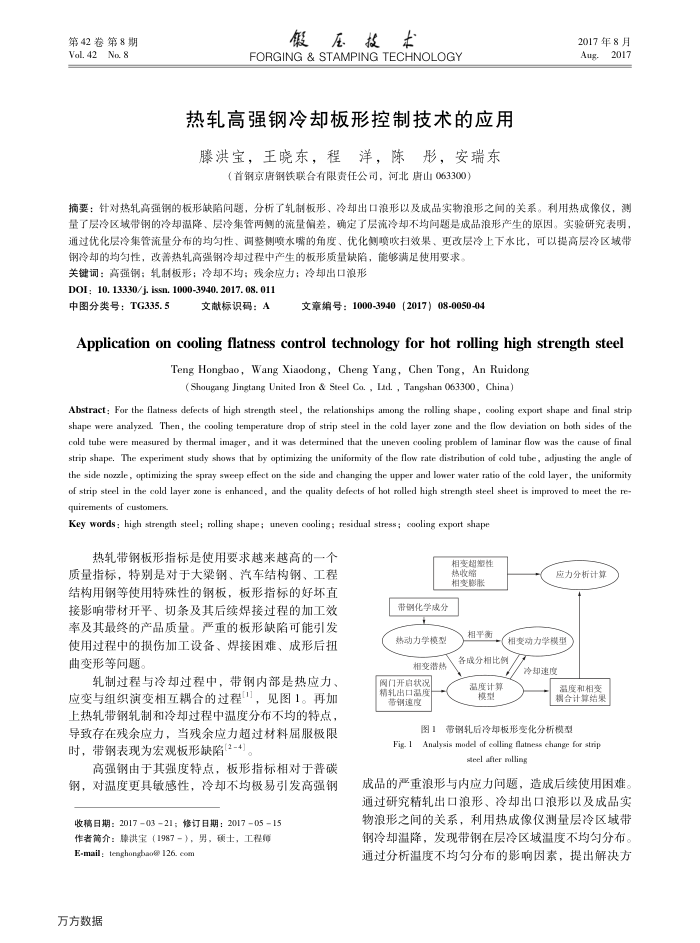您当前的位置:首页>论文资料>热轧高强钢冷却板形控制技术的应用
内容简介
 第42卷第8期 Vol. 42No. 8
第42卷第8期 Vol. 42No. 8锻压技术
FORGING &STAMPING TECHNOLOGY
热轧高强钢冷却板形控制技术的应用滕洪宝,王晓东,程洋,陈彤,安瑞东
(首钢京唐钢铁联合有限责任公司,河北唐山063300)
2017年8月 Aug-2017
摘要:针对热轧高强钢的板形缺陷问题,分析了轧制板形、冷却出口浪形以及成品实物浪形之间的关系。利用热成像仪,测量了层冷区域带钢的冷却温降、层冷集管两侧的流量偏差,确定了层流冷却不均问题是成品浪形产生的原因。实验研究表明,通过优化层冷集管流量分布的均匀性、调整侧喷水嘴的角度、优化侧喷吹扫效果、更改层冷上下水比,可以提高层冷区域带钢冷却的均匀性,改善热轧高强钢冷却过程中产生的板形质量缺陷,能够满足使用要求。
关键词:高强钢;轧制板形;冷却不均:残余应力;冷却出口浪形 DOI: 10. 13330/j. issn. 1000-3940. 2017. 08. 011
中图分类号:TG335.5
文献标识码:A
文章编号:1000-3940(2017)08-0050-04
Application on cooling flatness control technology for hot rolling high strength stee
Teng Hongbao,Wang Xiaodong,Cheng Yang,Chen Tong,An Ruidong( Shougang Jingtang United Iron & Steel Co. , Lid. , Tangshan 063300, China)
Abstract: For the flatness defects of high strength steel, the relationships among the rolling shape, cooling export shape and final strip shape were analyzed. Then, the cooling temperature drop of strip steel in the cold layer zone and the flow deviation on both sides of the cold tube were measured by thermal imager, and it was determined that the uneven cooling problem of laminar flow was the cause of final strip shape. The experiment study shows that by optimizing the uniformity of the flow rate distribution of cold tube, adjusting the angle of the side nozzle, optimizing the spray sweep effect on the side and changing the upper and lower water ratio of the cold layer, the uniformity of strip steel in the cold layer zone is enhanced, and the quality defects of hot rolled high strength steel sheet is improved to meet the re quirements of customers.
Key words : high strength steel; rolling shape; uneven cooling: residual stress; cooling export shapt
热轧带钢板形指标是使用要求越来越高的一个
质量指标,特别是对于大架钢、汽车结构钢、工程结构用钢等使用特殊性的钢板,板形指标的好坏直接影响带材开平、切条及其后续焊接过程的加工效率及其最终的产品质量。严重的板形缺陷可能引发使用过程中的损伤加工设备、焊接困难、成形后扭曲变形等向间题
轧制过程与冷却过程中,带钢内部是热应力、应变与组织演变相互耦合的过程],见图1。再加上热轧带钢轧制和冷却过程中温度分布不均的特点,导致存在残余应力,当残余应力超过材料届服极限时,带钢表现为宏观板形缺陷[2-4]。
高强钢由于其强度特点,板形指标相对于普碳钢,对温度更具敏感性,冷却不均极易引发高强钢
收稿日期:20170321;修订日期:20170515 作者简介:肆洪宝(1987-),男,硕士,工程师 E-mail: tenghonghao@ 126. com
万方数据
带例化学成分热动力学模型
相变潜热
图门开启状况精轧出口温度带钢速度
图
Fig. 1
相变超整性
热收缩相变胞
应力分析计算
相变动力学模型
各成分相比例温度计算需避
冷却速度
温度和相变稠合计算结果
带钢轧后冷却板形变化分析模型
Analysis model of colling flatness change foer strip
steel after molling
成品的严重浪形与内应力问题,造成后续使用困难。通过研究精轧出口浪形、冷却出口浪形以及成品实物浪形之间的关系,利用热成像仪测量层冷区域带钢冷却温降,发现带钢在层冷区域温度不均勾分布。通过分析温度不均勾分布的影响因素,提出解决方